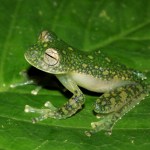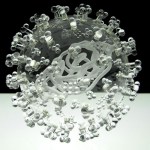glass
Researchers in Peru have discovered four new species of tiny so-called "glass frogs" (family: Centrolenidae).
Centrolene charapita: with the yellow splotches on its back, this species was aptly named after little yellow chili peppers. Their hindlegs also had fleshy little zigzag-like protuberances whose purpose is unknown.
Figure 4 from Twomey et al. Zootaxa, 2014.
Cochranella guayasamini: This species is mostly green with yellow encircling its eyes. Interestingly, the tadpoles begin as a reddish pink color. Since they live in streambeds that are low in oxygen, this coloration…
This weekend I visited the Trauma exhibition at London's GV Art gallery. The pieces all relate in some way to physical and psychological trauma inflicted on the body, by a range of artists working alone and in collaboration with medics.
Some of the items are underwhelming verging on irritating - placing histological slides on a plinth does a disservice both to art (because there is no emotional narrative contained within) and to science, because it implies that the inherent wonder and beauty of science is absent unless it is repackaged as a gallery exhibit. (Hello? Museums present objects…
Last week I had a visit from a friend of mine, who was on something of a farewell tour. After several years of planning, he'd packed in his dependable but much-begrudged corporate job, and was setting sail for Asia, to see more of the world. He's already seen much more of the world than most people. Not because he was well connected or rich, but because he made it his life's mission to tour the forgotten, the hidden and the forbidden places of the world. I mention this because if there ever was a man to take life advice from, it is this one, and he put into words something I've been…
You may remember Wesley Fleming, the glass artist I blogged about last year. It seems he's accomplished a remarkable new piece: a leafcutter ant infected with a parasitic Cordyceps fungus. As far as I know this is the first Cordyceps ever created from glass.
If you'd like to see it in person, this and some of Fleming's other pieces will be on display at the Racine Art Museum this summer.
What is Cordyceps, you ask? Watch:
A comment left on this blog last week alerted me to the sublime glasswork of artist Wesley Fleming. Wow. Not only are the pieces aesthetically stunning, they are also largely anatomically accurate. Legs attached to the right spots, tarsal segments counted out, tibial spurs in place.
If you have a few minutes, do yourself a favor and visit Fleming's gallery.
StickyBot is a robot designed by researchers at Stanford Biomimetics and Dexterous Manipulation Lab as part of the Robots in Scansorial Environments project (RiSE). The robotic gecko tests their hypotheses about the "requirements for mobility on vertical surfaces using dry adhesion. The main point is that we don't need more adhesion, we need controllable adhesion."
The site boils down the "key ingredients" as follows:
* hierarchical compliance for conforming at centimeter, millimeter and micrometer scales,
* anisotropic dry adhesive materials and structures so that we can…
I was doing a little research into the history of telescopes, and it was about a century ago that they finally realized how much more potential light-gathering power reflecting telescopes had as compared to the older refracting telescopes. On Mt. Wilson in California, astronomer George Ellery Hale and optician George Willis Ritchey (back then everybody was named George -- look it up!) were embarking on a program to build large reflecting telescopes as the wave-of-the-future of Astronomy.
But even before this telescope was operational, Hale and Ritchey were thinking of bigger and bigger…
tags: glass, scissors, streaming video
Who would have thought?
It's like something Homer Simpson would try.
I can see how this could come in handy for some kind of art piece. [1:15]


